Sculpting the urban guts: an interview with Holly Hendry
A sculptural installation on the roof of Temple Station, central London, uses architectural & engineering pipes to make new connections to space - and perhaps to Joseph Bazalgette’s sewers beneath. In a free-to-access public space curated by theCoLAB, artist Holly Hendry has created an uncanny & unnerving waved entanglement of colourful pipes, as explored in this interview with recessed.space.
Holly Hendry is a London-based artist whose sculptural
interventions play with ideas around the grotesque alongside human or architectural
processes often hidden from sight and mind, often using engineering components twisted with playful colour and unexpected arrangements.
Pipes frequently pop up in her works, protruding from gallery walls, or forming
unexpected connections in public spaces, trailing around like a worm.
One of her pipes how now popped up in Temple, central London, appearing as if some haywire engineering gone wrong. In a new temporary installation, Slackwater, for arts organisation theCoLAB. It reads as a vast interlocking mesh of ventilation pipes, formed of standard engineering products but with cartoon-like colour and shaped into an uncanny form, expanding motifs which have recurred through her artistic career: notably Homeostasis (2014) for Sharjah Art Foundation, Deep Soil Thrombosis (2019) for La Biennale de Lyon, Invertebrate (2021) at the Erich Mendelssohn-designed De La Warr Pavilion in Bexhill-on-Sea – a version of which was also included in Testament, a group exhibition at Goldsmiths Centre for Contemporary Art [CCA].
![]()
![]()
![]()
![]()
Slackwater sits on the publicly-accessible roof of Temple Underground Station, built in 1872 in conjunction with the Victoria Embankment, Joseph Bazalgette’s grand project to provide London with a modern sewerage system. The city’s newest super sewer, the Thames Tideway Tunnel, is set to complete in 2025, helping cope with rainwater overflow and the waste of modern society – including pipe-clogging fatbergs.
The following previously-unpublished interview took place in February 2022 to coincide with Goldsmith CCA’s Testament exhibition, though much of the conversation speaks to issues exploredby Hendry further in Slackwater. The sixth artist invited by theCoLAB to contribute to a space coined The Artist’s Garden, Hendry’s humorous woven pipes of cartoon-colours and imagined connections to Londoners’ modern waste and Bazalgette’s historic sewers sit overlooking the Thames as a static rhythm, inviting new ideas of movement and association.
![]()
![]()
recessed.space: Your work sits in a space between art and architecture. What is that space to you?
Holly Hendry: We inhabit and experience both architecture and art with our bodies. I don't see too much difference in the sense of what architecture, art, and sculpture can do with space and how we interpret it. It can cut through or interrupt space, entangle our relationship with it.
Space and site is the starting point for my work. I try and undo it or dig it up, or try and pull the architecture into the succulence of the sculpture, or navigate it in a way you'd maybe not expect. I'm always frustrated with architecture being something that is thought about and talked about as function – I think sculpture is really good at doing the opposite of that sometimes, being brilliantly useful in its uselessness.
recessed.space: So, do you come from the Gordan Mata Clarke school of architectural imagining?
Holly Hendry: I don't know if it has that much machismo in it! I'd like to see myself as a bit more delicately chewing architecture, not taking it apart to put it back together again – but taking it apart to break down an opportunity for reconsideration.
Which speaks to that notion of the worm, which recurs in your work – an idea of digesting, transforming, but leaving a strata or index of what was there before.
The worm started in a project for the De la Warr Pavilion. It was a response to being on the edge of the land, Britain, Brexit, and the pandemic. I was thinking about the act of an edge, and what trespasses edges. I researched different types of worms, from ship worms – which eat into the wood of boats and become passengers, so much that they can sink the boats – to tooth worms – which people used to think caused toothache because of the sensation of something burrowing.
It became creepily relevant with Brexit, the pandemic, and Black Lives Matter movement – monuments were being toppled and borders were being put up. So the worm became loaded. After what maybe seemed like a bit of a dumb gesture – putting a big earthworm on the coast – it felt like something that could be a symbol of where we were at the moment and of change.
![]()
![]()
![]()
The idea of the fearful comes up in your work.
There's a horror in trespassing a membrane, or of being inside and outside. I'm really interested in budget horror effects, but also the architecture within horror films. I think that the Goldsmiths CCA building exposes its insides in a body horror, scifi way. It reveals.
Assemble, the architects who created Goldsmiths CCA, seem to have chipped away at the superfluous skin to find some truth underneath – but actually that truth is all over the place, it’s confused and upsetting.
It’s like a lot of London, where things have been botched and put back into places that they’re not meant to be, you see strange connections between things. That way of building – or rebuilding – is very present in my mind as well because of having worked at the De La Warr Pavilion, which has so much connection to the modernist line. I have been looking a lot at Le Corbusier's approach to disease and architecture, and how sanatoriums try to make everything wipe-clean, away from the ground. And here I was like really trying to bring back out those entrails. Le Corbusier talked about the house as a type of machine, but all those guts were there but tidied away – I was interested in trying to pull the guts out again.
![]()
![]()
![]()
Tell us about the tonal range and use of colour across your work.
There is a kind of translation into my own language or environment. I'm really interested in the idea of a cartoon world with a set of rules – or non-rules. I use the example of the film Who Framed Roger Rabbit, because the human-acted bodies become all the more fragile and human, almost grotesque in a way. I try and use colour to create rules from which the work can exist, where line and colour is exaggerated, and it becomes sickeningly sweet, even though you're dealing with something that's more composty, talking about break down, decomposition, fatbergs, and the muckier side of life. I'd hope that the work lures you in, or kind of seduces you up close, then spits you back out again.
Things that happen in cartoons is often terrifying. Not least in violence between characters, but especially in the way it constantly breaks the fourth wall, or disrupts an expectation of space or gravity.
In the cartoon world, death is reversible – you bounce back after falling from a cliff. So it might become attached to humour instead of horror, but it's still got horror in it – it’s just not like at the forefront of your mind. Maybe it's more horrible, more horrific. I try and do the same with my work in combining humour and horror.
![]()
![]()
![]()
On the description of your work for Goldsmiths CCA, you stated that the work displays “putrification as permanence.” I think of that in relation to the city around us and an idea of constant decay which is often visible. I am interested in your work in the broader city, outside of a gallery, and if it could take on a larger scale, like one of your pipe sculptures taking over a whole building?
I don't want to be known as that pipework artist, but in a way it's a great language to be able to talk about these ideas through stock materials intended as a system for architecture. The idea about breakdown in the city is really interesting, because we're quite used to feeling like we're separate to that grubby idea of being surrounded by decomposition and breakdown. But we aren’t, and it's not something that just happens below our feet, but up in our face as well. We just get used to it, compared to somewhere like Rome, where that breakdown is, like more preserved, or glorified. Breakdown in a London sense is very much more day-to-day – chewing gum on the pavement, leaking roofs.
And on the Thames foreshore, especially around the north side at the bend of Blackfriars Bridge, there are 1000s of bones, from boars to dogs… I don't know what other animals...
My studio is in Greenwich, and I used to be in Woolwich, which is such a strange edgeland that feels like the Thames foreshore industrialised. There are strange heaps of metal waste, then you've got abandoned parts of the river with shopping trolleys and bones. I love those parts of London, there's something very haptic about them.
One of her pipes how now popped up in Temple, central London, appearing as if some haywire engineering gone wrong. In a new temporary installation, Slackwater, for arts organisation theCoLAB. It reads as a vast interlocking mesh of ventilation pipes, formed of standard engineering products but with cartoon-like colour and shaped into an uncanny form, expanding motifs which have recurred through her artistic career: notably Homeostasis (2014) for Sharjah Art Foundation, Deep Soil Thrombosis (2019) for La Biennale de Lyon, Invertebrate (2021) at the Erich Mendelssohn-designed De La Warr Pavilion in Bexhill-on-Sea – a version of which was also included in Testament, a group exhibition at Goldsmiths Centre for Contemporary Art [CCA].
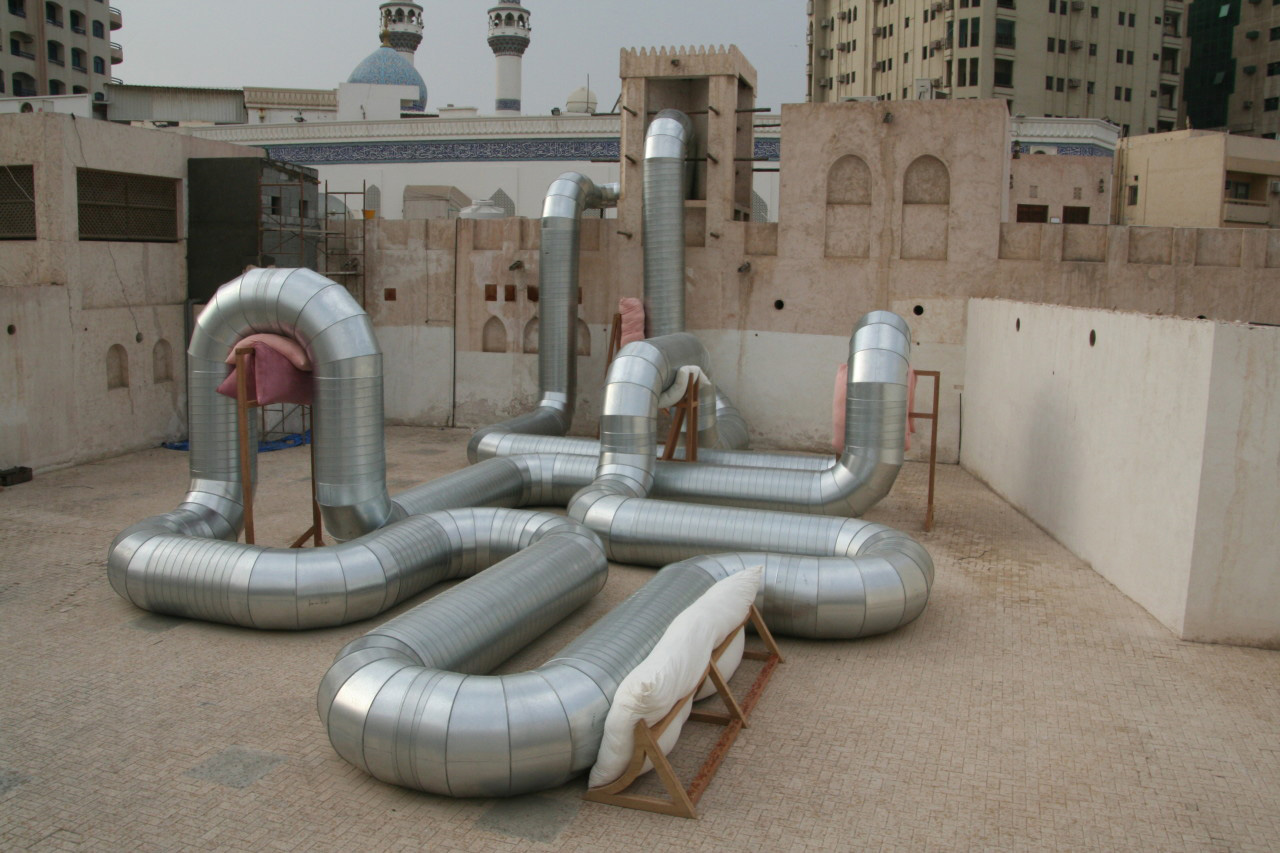
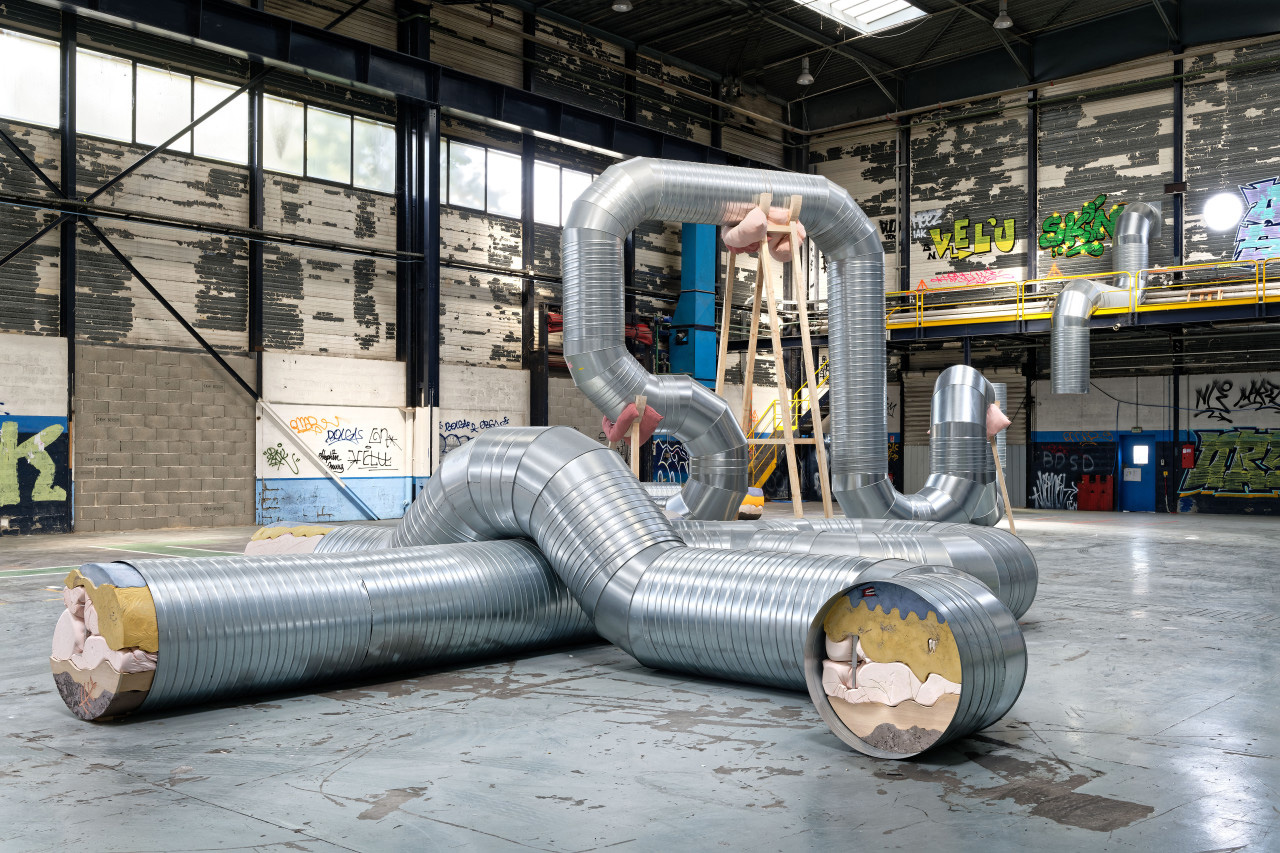


Figs.i-iv
Slackwater sits on the publicly-accessible roof of Temple Underground Station, built in 1872 in conjunction with the Victoria Embankment, Joseph Bazalgette’s grand project to provide London with a modern sewerage system. The city’s newest super sewer, the Thames Tideway Tunnel, is set to complete in 2025, helping cope with rainwater overflow and the waste of modern society – including pipe-clogging fatbergs.
The following previously-unpublished interview took place in February 2022 to coincide with Goldsmith CCA’s Testament exhibition, though much of the conversation speaks to issues exploredby Hendry further in Slackwater. The sixth artist invited by theCoLAB to contribute to a space coined The Artist’s Garden, Hendry’s humorous woven pipes of cartoon-colours and imagined connections to Londoners’ modern waste and Bazalgette’s historic sewers sit overlooking the Thames as a static rhythm, inviting new ideas of movement and association.
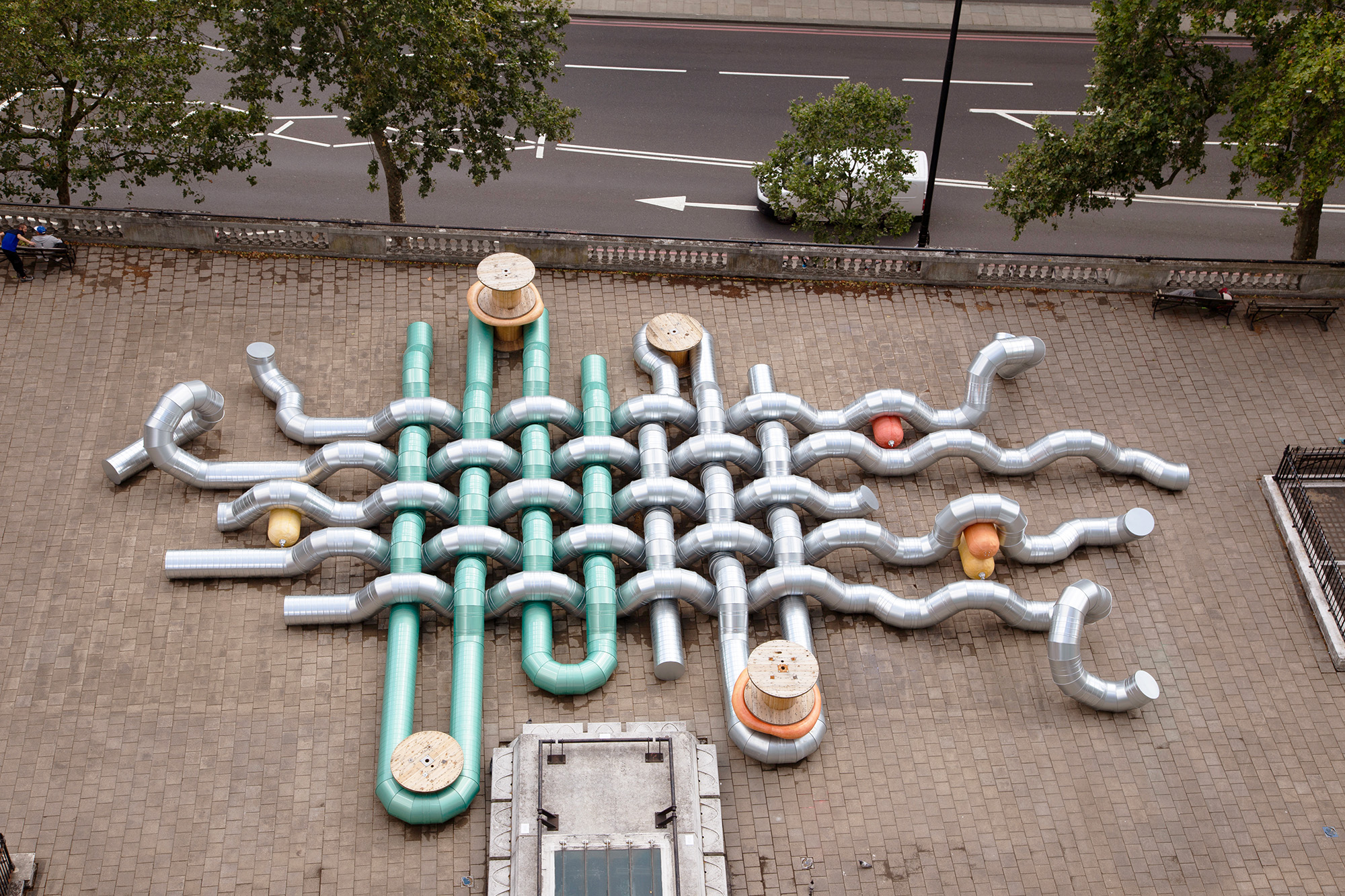

Figs.v,vi
recessed.space: Your work sits in a space between art and architecture. What is that space to you?
Holly Hendry: We inhabit and experience both architecture and art with our bodies. I don't see too much difference in the sense of what architecture, art, and sculpture can do with space and how we interpret it. It can cut through or interrupt space, entangle our relationship with it.
Space and site is the starting point for my work. I try and undo it or dig it up, or try and pull the architecture into the succulence of the sculpture, or navigate it in a way you'd maybe not expect. I'm always frustrated with architecture being something that is thought about and talked about as function – I think sculpture is really good at doing the opposite of that sometimes, being brilliantly useful in its uselessness.
recessed.space: So, do you come from the Gordan Mata Clarke school of architectural imagining?
Holly Hendry: I don't know if it has that much machismo in it! I'd like to see myself as a bit more delicately chewing architecture, not taking it apart to put it back together again – but taking it apart to break down an opportunity for reconsideration.
Which speaks to that notion of the worm, which recurs in your work – an idea of digesting, transforming, but leaving a strata or index of what was there before.
The worm started in a project for the De la Warr Pavilion. It was a response to being on the edge of the land, Britain, Brexit, and the pandemic. I was thinking about the act of an edge, and what trespasses edges. I researched different types of worms, from ship worms – which eat into the wood of boats and become passengers, so much that they can sink the boats – to tooth worms – which people used to think caused toothache because of the sensation of something burrowing.
It became creepily relevant with Brexit, the pandemic, and Black Lives Matter movement – monuments were being toppled and borders were being put up. So the worm became loaded. After what maybe seemed like a bit of a dumb gesture – putting a big earthworm on the coast – it felt like something that could be a symbol of where we were at the moment and of change.
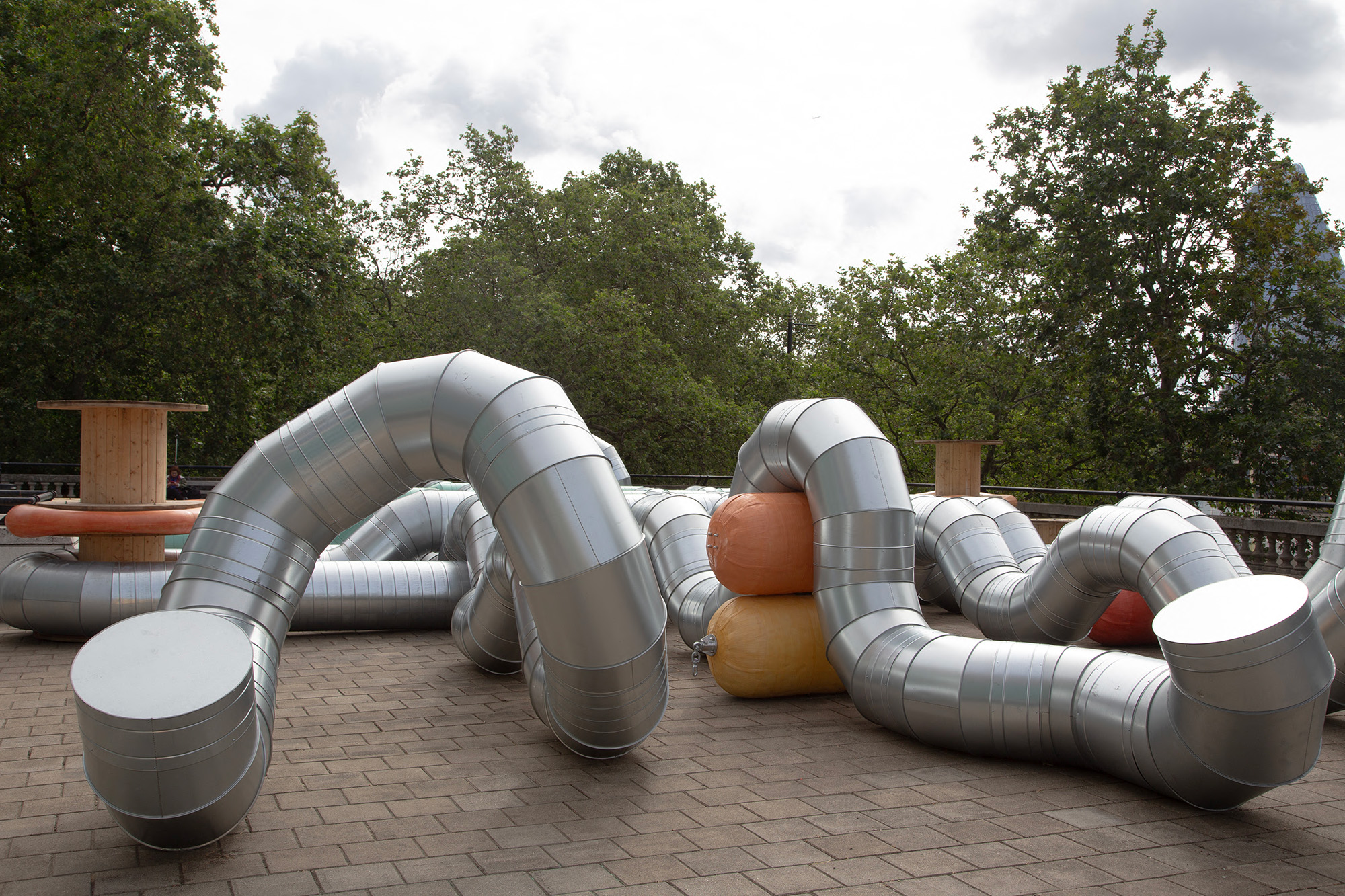
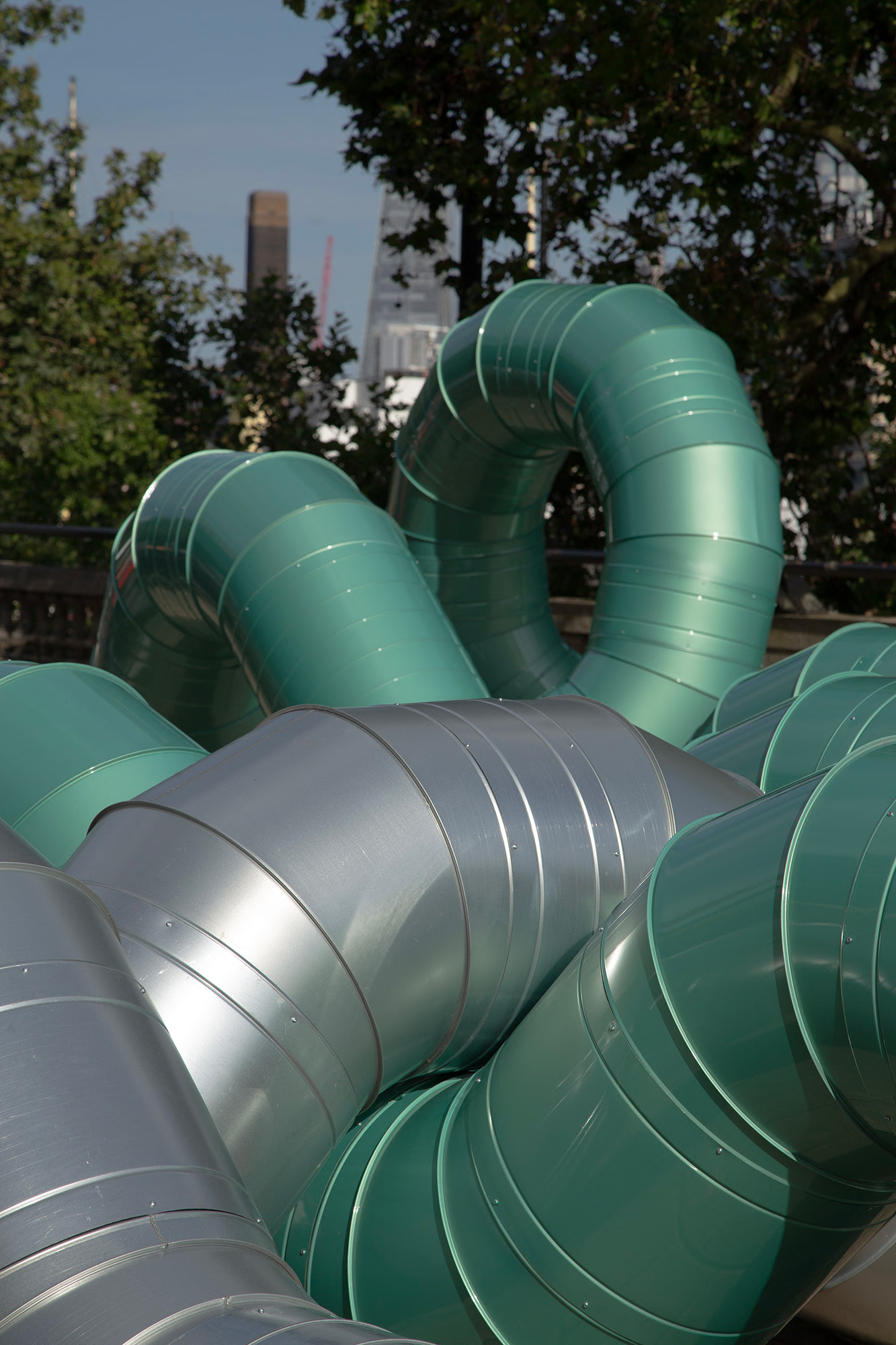
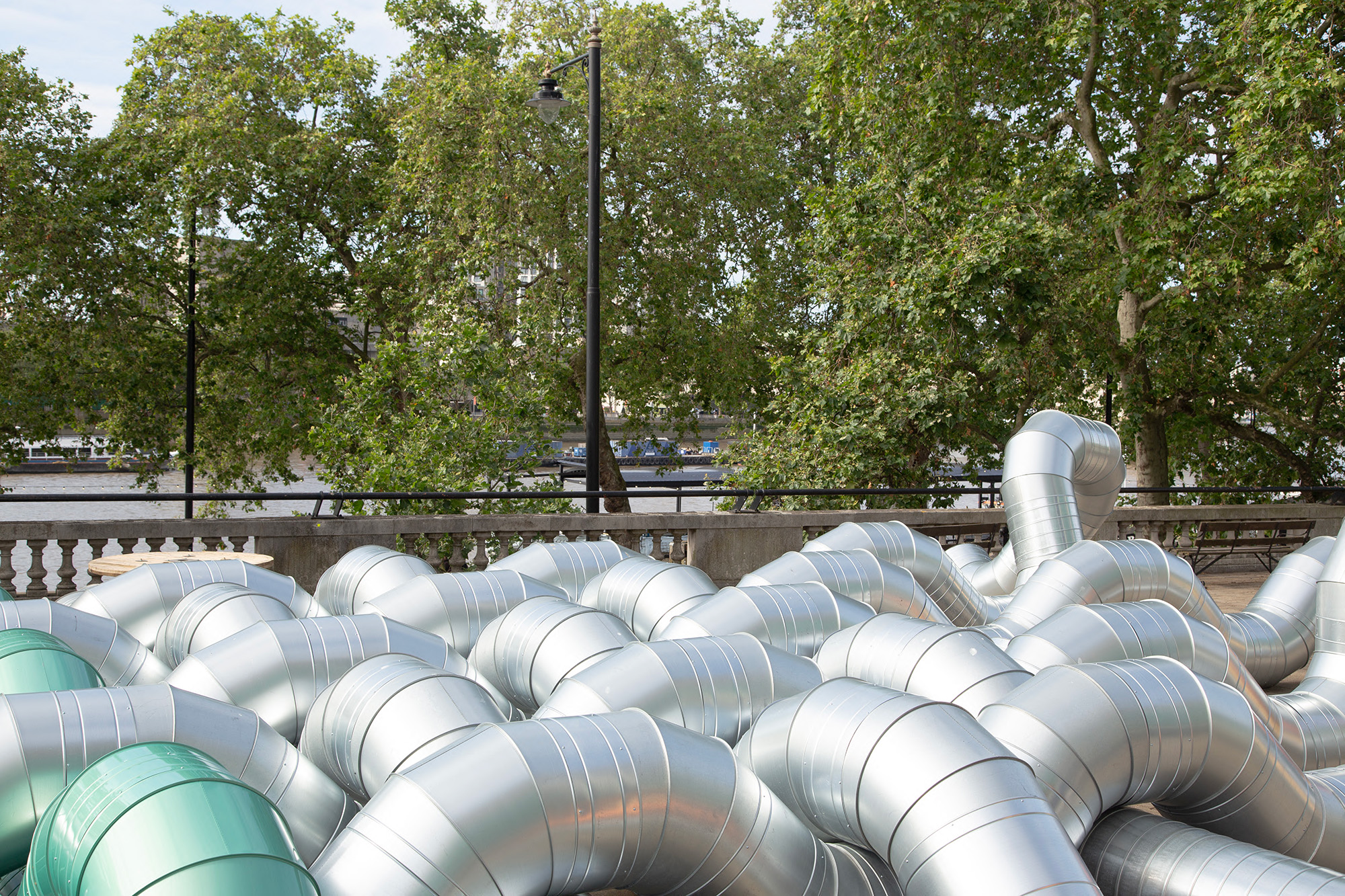
Figs.vii-ix
The idea of the fearful comes up in your work.
There's a horror in trespassing a membrane, or of being inside and outside. I'm really interested in budget horror effects, but also the architecture within horror films. I think that the Goldsmiths CCA building exposes its insides in a body horror, scifi way. It reveals.
Assemble, the architects who created Goldsmiths CCA, seem to have chipped away at the superfluous skin to find some truth underneath – but actually that truth is all over the place, it’s confused and upsetting.
It’s like a lot of London, where things have been botched and put back into places that they’re not meant to be, you see strange connections between things. That way of building – or rebuilding – is very present in my mind as well because of having worked at the De La Warr Pavilion, which has so much connection to the modernist line. I have been looking a lot at Le Corbusier's approach to disease and architecture, and how sanatoriums try to make everything wipe-clean, away from the ground. And here I was like really trying to bring back out those entrails. Le Corbusier talked about the house as a type of machine, but all those guts were there but tidied away – I was interested in trying to pull the guts out again.

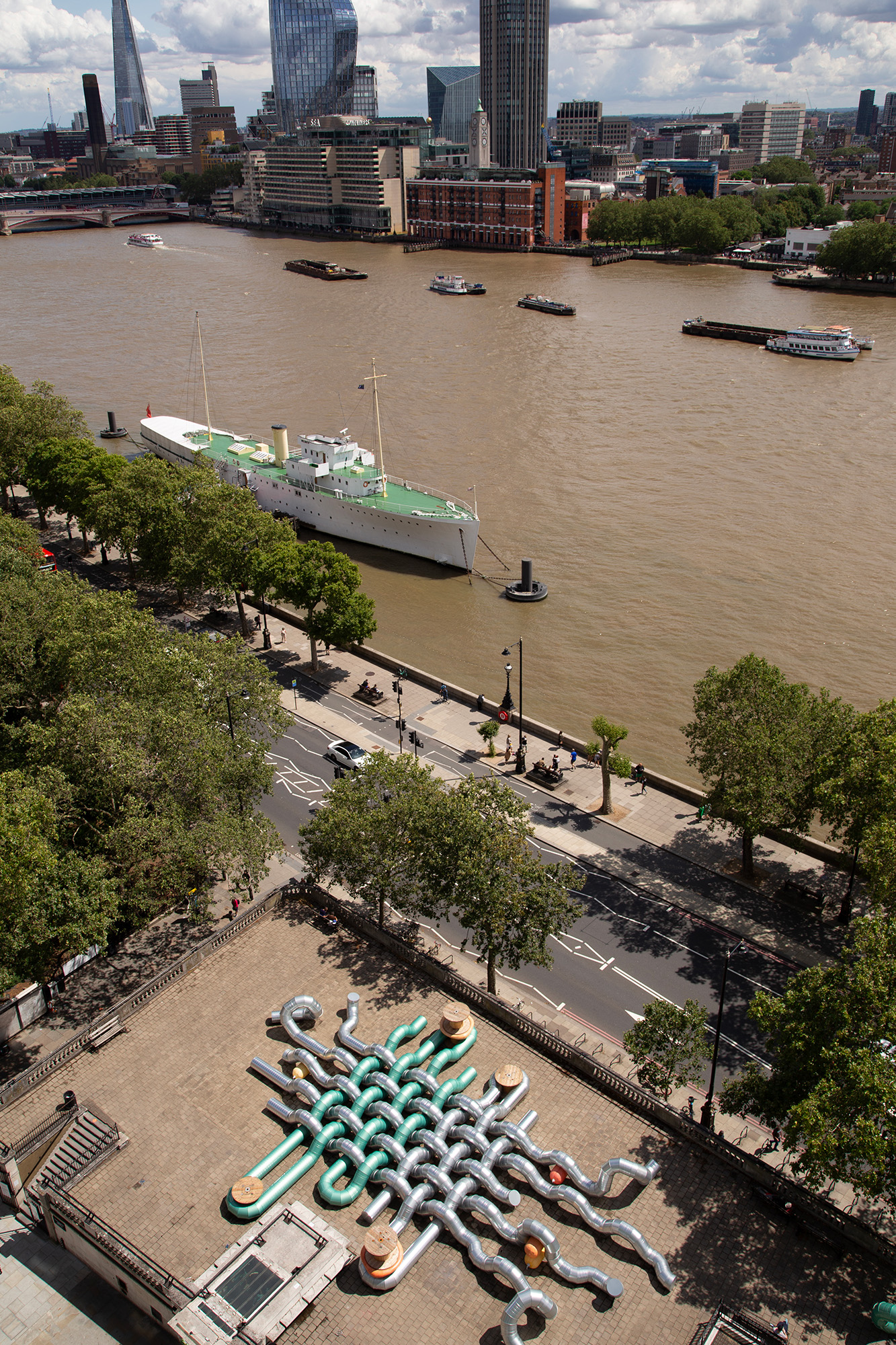
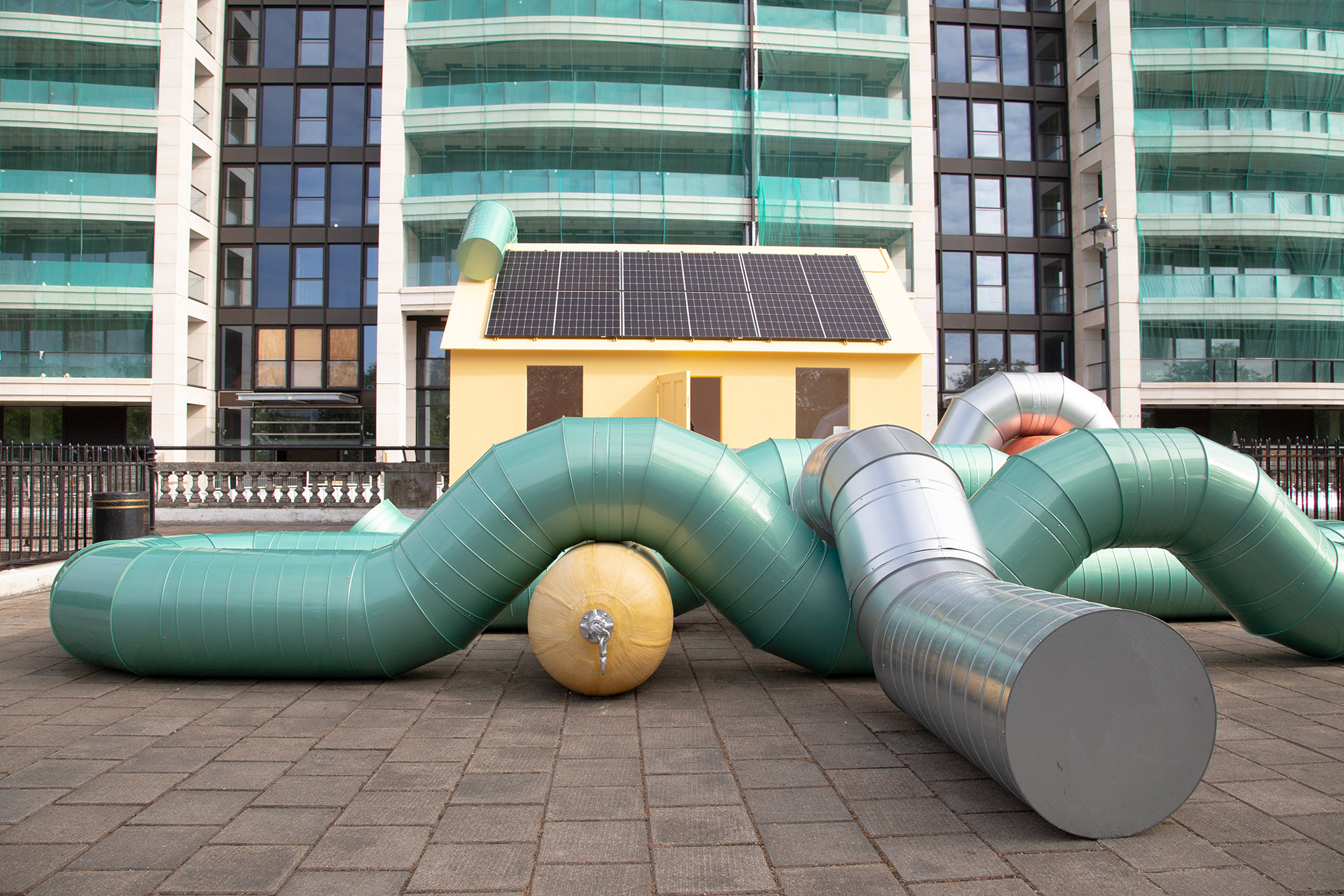
Figs.x-xii
Tell us about the tonal range and use of colour across your work.
There is a kind of translation into my own language or environment. I'm really interested in the idea of a cartoon world with a set of rules – or non-rules. I use the example of the film Who Framed Roger Rabbit, because the human-acted bodies become all the more fragile and human, almost grotesque in a way. I try and use colour to create rules from which the work can exist, where line and colour is exaggerated, and it becomes sickeningly sweet, even though you're dealing with something that's more composty, talking about break down, decomposition, fatbergs, and the muckier side of life. I'd hope that the work lures you in, or kind of seduces you up close, then spits you back out again.
Things that happen in cartoons is often terrifying. Not least in violence between characters, but especially in the way it constantly breaks the fourth wall, or disrupts an expectation of space or gravity.
In the cartoon world, death is reversible – you bounce back after falling from a cliff. So it might become attached to humour instead of horror, but it's still got horror in it – it’s just not like at the forefront of your mind. Maybe it's more horrible, more horrific. I try and do the same with my work in combining humour and horror.
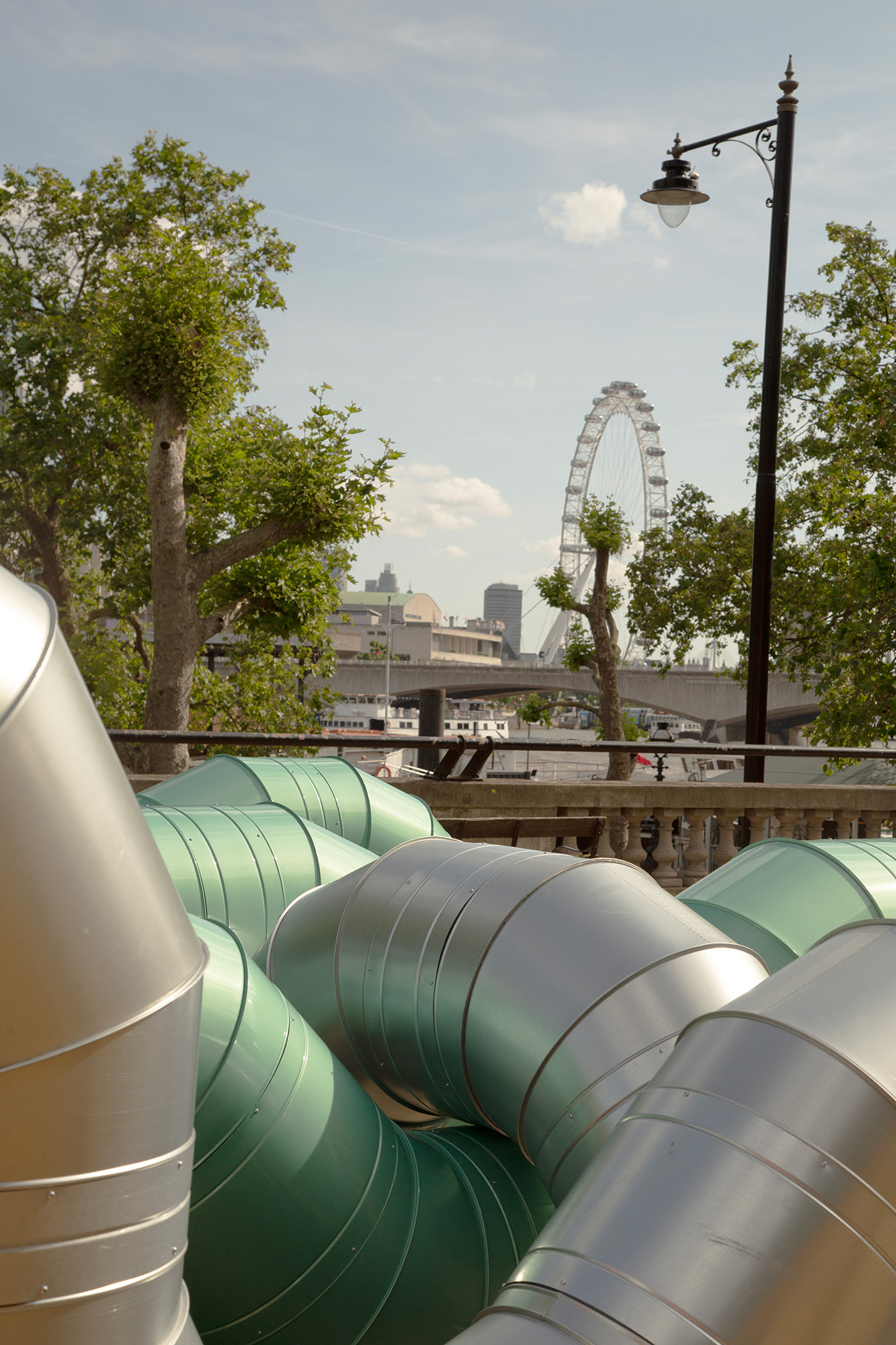

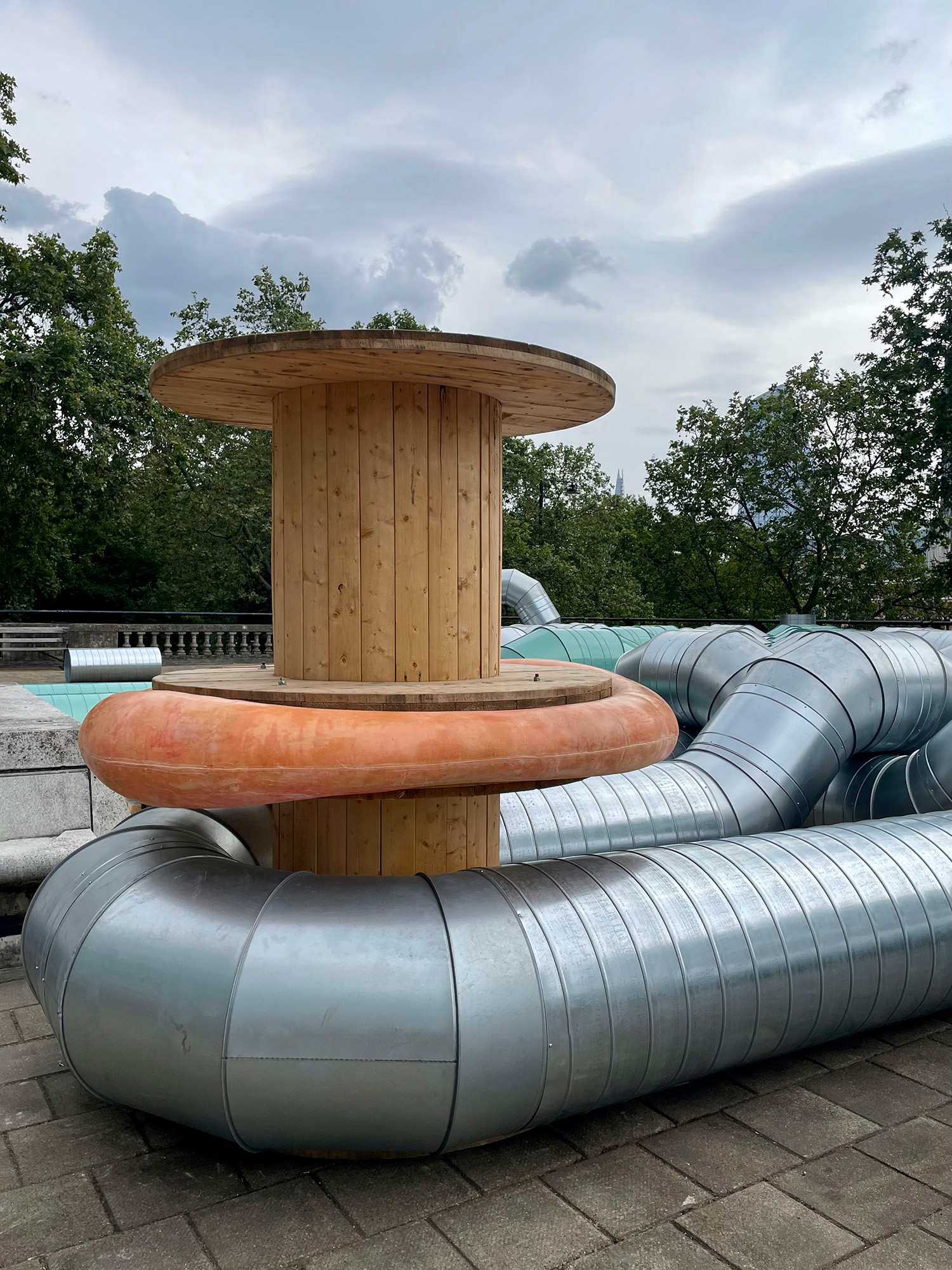
Figs.xiii-xv
On the description of your work for Goldsmiths CCA, you stated that the work displays “putrification as permanence.” I think of that in relation to the city around us and an idea of constant decay which is often visible. I am interested in your work in the broader city, outside of a gallery, and if it could take on a larger scale, like one of your pipe sculptures taking over a whole building?
I don't want to be known as that pipework artist, but in a way it's a great language to be able to talk about these ideas through stock materials intended as a system for architecture. The idea about breakdown in the city is really interesting, because we're quite used to feeling like we're separate to that grubby idea of being surrounded by decomposition and breakdown. But we aren’t, and it's not something that just happens below our feet, but up in our face as well. We just get used to it, compared to somewhere like Rome, where that breakdown is, like more preserved, or glorified. Breakdown in a London sense is very much more day-to-day – chewing gum on the pavement, leaking roofs.
And on the Thames foreshore, especially around the north side at the bend of Blackfriars Bridge, there are 1000s of bones, from boars to dogs… I don't know what other animals...
My studio is in Greenwich, and I used to be in Woolwich, which is such a strange edgeland that feels like the Thames foreshore industrialised. There are strange heaps of metal waste, then you've got abandoned parts of the river with shopping trolleys and bones. I love those parts of London, there's something very haptic about them.
Holly Hendry lives and works in London. In 2018 she was Rome Fellow in Contemporary Art at the British School at Rome, and in January 2019 was awarded the Arts Foundation Award for Experimental Architecture. Hendry makes sculptures that give physical form to ideas of emptiness, edges, flatness, fakes & forgeries - things that are missing or unknown. Hendry is interested in defining the architecture of spaces and their perceived limits by exploring scale, surface, colour and density using a wide range of materials in her installations.
Hendry has exhibited & been commissioned widely, including: Lip-sync (2023) Birmingham; Sump (2022), ESCH2022, Luxembourg; SCAD (2024), Georgia; the De La Warr Pavilion 2021; BALTIC Centre for
Contemporary Art, 2017; Sharjah Art Foundation, Sharjah, 2014; Liverpool Biennial,
2018; Breaking the Mould: Sculpture by Women since 1945, Yorkshire Sculpture
Park, 2021; Beano: The Art of Breaking Rules, Somerset House, 2021. Her work is in the Arts Council, British
Council & Government Art Collections, UK and FRAC Grand Large, France. She is represented by Stephen Friedman Gallery & is lecturer at the UCL Slade School of Fine Art.
www.hollyhendry.com
theCoLAB is a women-led
collaborative laboratory working beyond the confines of the white cube. It commissions
artists to realise their most far-flung and life-affirming work in response to unusual
sites to intrigue and engage the public. The Artist’s Garden transformed the neglected half acre rooftop
on Temple tube station into a vast free public sculpture garden for women
artists to enhance their visibility and promote greater appreciation of their
work in the field of outdoor sculpture.
www.thecolab.art
www.thecolab.art
visit
Slackwater by Holly Hendry can be visited for free at The Artist’s Garden, on the roof of Temple tube
station, Temple Place, London WC2R 2PH.
Open daily from 8am with seasonal closing times
at dusk.
More information available at: www.thecolab.art/temple
images
fig.i Holly Hendry, Homeostasis (2014), Sharjah Art Foundation. Photograph courtesy of the artist.
fig.ii Holly Hendry, Deep Soil Thrombosis (2019), La
Biennale de Lyon.
Photograph courtesy of the artist.
fig.iii Holly Hendry, Invertebrate (2021), De La Warr Pavilion. Photograph courtesy of the artist.
fig.iv Holly Hendry, Invertebrate (2021), at Testament, Goldsmiths Centre for
Contemporary Art. Photograh © Rob Harris
fig.v-xv
Holly Hendry, Invertebrate (2021), for The Artist’s Garden, London, produced by theCoLAB. Photographs © Hells Gibson
publication date
25/07/23
tags
Joseph Bazalgette, Brexit, Cartoon, Comic, Covid, De La Warr Pavilion, Earth, Engineering, Fear, Flow, Goldsmiths CCA, Holly Hendry, Horror, London, Pipes, Sewerage, Sewer, Temple, The CoLAB, Thames Tideway Tunnel, The Artists Garden, theCoLAB, Underground, Ventilation, Who Framed Roger Rabit, Wave, Weave, Worms
More information available at: www.thecolab.art/temple


